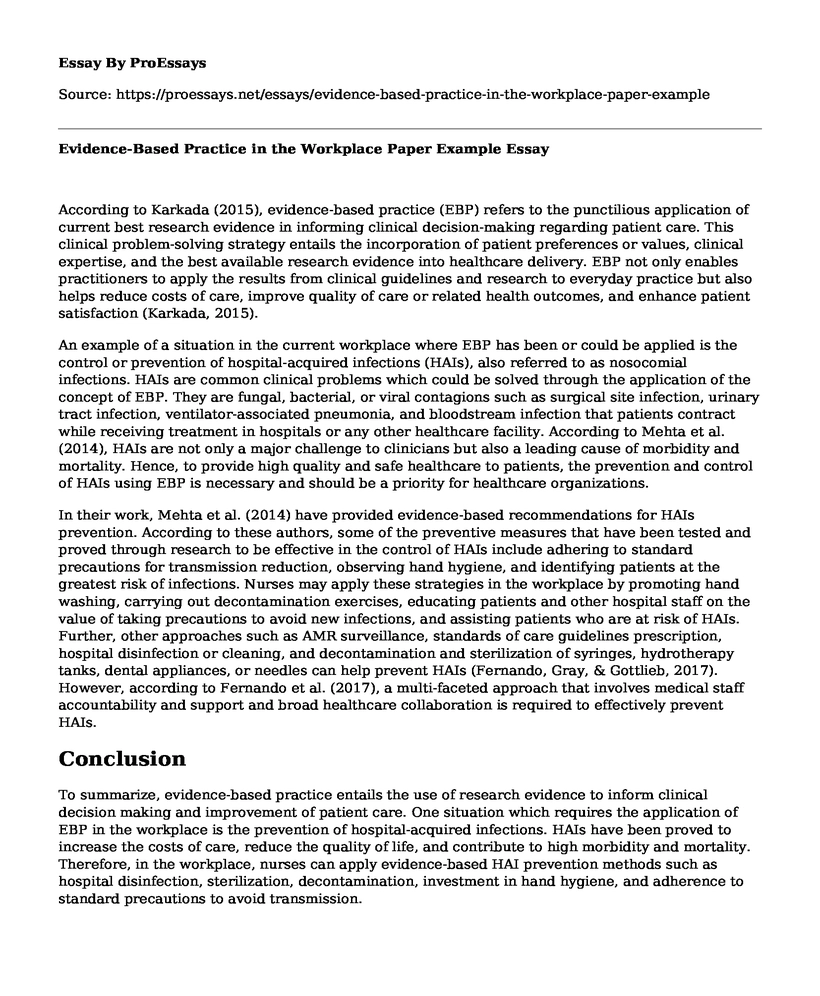According to Karkada (2015), evidence-based practice (EBP) refers to the punctilious application of current best research evidence in informing clinical decision-making regarding patient care. This clinical problem-solving strategy entails the incorporation of patient preferences or values, clinical expertise, and the best available research evidence into healthcare delivery. EBP not only enables practitioners to apply the results from clinical guidelines and research to everyday practice but also helps reduce costs of care, improve quality of care or related health outcomes, and enhance patient satisfaction (Karkada, 2015).
An example of a situation in the current workplace where EBP has been or could be applied is the control or prevention of hospital-acquired infections (HAIs), also referred to as nosocomial infections. HAIs are common clinical problems which could be solved through the application of the concept of EBP. They are fungal, bacterial, or viral contagions such as surgical site infection, urinary tract infection, ventilator-associated pneumonia, and bloodstream infection that patients contract while receiving treatment in hospitals or any other healthcare facility. According to Mehta et al. (2014), HAIs are not only a major challenge to clinicians but also a leading cause of morbidity and mortality. Hence, to provide high quality and safe healthcare to patients, the prevention and control of HAIs using EBP is necessary and should be a priority for healthcare organizations.
In their work, Mehta et al. (2014) have provided evidence-based recommendations for HAIs prevention. According to these authors, some of the preventive measures that have been tested and proved through research to be effective in the control of HAIs include adhering to standard precautions for transmission reduction, observing hand hygiene, and identifying patients at the greatest risk of infections. Nurses may apply these strategies in the workplace by promoting hand washing, carrying out decontamination exercises, educating patients and other hospital staff on the value of taking precautions to avoid new infections, and assisting patients who are at risk of HAIs. Further, other approaches such as AMR surveillance, standards of care guidelines prescription, hospital disinfection or cleaning, and decontamination and sterilization of syringes, hydrotherapy tanks, dental appliances, or needles can help prevent HAIs (Fernando, Gray, & Gottlieb, 2017). However, according to Fernando et al. (2017), a multi-faceted approach that involves medical staff accountability and support and broad healthcare collaboration is required to effectively prevent HAIs.
Conclusion
To summarize, evidence-based practice entails the use of research evidence to inform clinical decision making and improvement of patient care. One situation which requires the application of EBP in the workplace is the prevention of hospital-acquired infections. HAIs have been proved to increase the costs of care, reduce the quality of life, and contribute to high morbidity and mortality. Therefore, in the workplace, nurses can apply evidence-based HAI prevention methods such as hospital disinfection, sterilization, decontamination, investment in hand hygiene, and adherence to standard precautions to avoid transmission.
References
Fernando, S.A., Gray, T.J., & Gottlieb, T. (2017). Healthcareacquired infections: preventionstrategies. International Medicine Journal, 47l, 1341- 1351. doi:10.1111/imj.13642
Karkada, S. (2015). Evidence-based practice. International Journal of Nursing Research and Practice, 2(2), 1-4. Retrieved from https://www.researchgate.net/publication/295235501_Evidence_Based_Practice
Mehta, Y., Gupta, A., Todi, S., Myatra, S.N., Samaddar, D.P., Patil, V., Bhattacharya, P.K., & Ramasubban, S. (2014). Guidelines for the prevention of hospital-acquired infections. IndianJournal of Critical Care Medicine, 18(3), 149-163. doi: [10.4103/0972-5229.128705]
Cite this page
Evidence-Based Practice in the Workplace Paper Example. (2022, Sep 21). Retrieved from https://proessays.net/essays/evidence-based-practice-in-the-workplace-paper-example
If you are the original author of this essay and no longer wish to have it published on the ProEssays website, please click below to request its removal:
- Essay Example - The Social Model of Disability
- Conceptualization of Nursing Practice Paper
- Social Work Staff and Students Involved in the Social Work Profession in Institutions of Higher Learning
- Article Analysis Essay on Effective Implementation of Public Health Campaign Programs
- Evaluating Performance Measures in Nursing Homes Paper Example
- Essay Example on Rural & Remote Nursing: Bridging the Gap in Healthcare
- Sedation and Alternative Techniques in Helping Pediatric Patients During MR Imaging - Paper Sample







